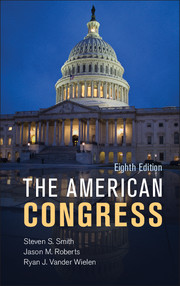Book contents
- Frontmatter
- Contents
- PREFACE
- Acknowledgments
- 1 The Troubled Congress
- 2 Representation and Lawmaking in Congress
- 3 Congressional Elections and Policy Alignments
- 4 Members, Goals, Resources, and Strategies
- 5 Parties and Leaders
- 6 The Standing Committees
- 7 The Rules of the Legislative Game
- 8 The Floor and Voting
- 9 Congress and the President
- 10 Congress and the Courts
- 11 Congress, Lobbyists, and Interest Groups
- 12 Congress and Budget Politics
- Appendix Introduction to the Spatial Theory of Legislating
- Index
- References
5 - Parties and Leaders
- Frontmatter
- Contents
- PREFACE
- Acknowledgments
- 1 The Troubled Congress
- 2 Representation and Lawmaking in Congress
- 3 Congressional Elections and Policy Alignments
- 4 Members, Goals, Resources, and Strategies
- 5 Parties and Leaders
- 6 The Standing Committees
- 7 The Rules of the Legislative Game
- 8 The Floor and Voting
- 9 Congress and the President
- 10 Congress and the Courts
- 11 Congress, Lobbyists, and Interest Groups
- 12 Congress and Budget Politics
- Appendix Introduction to the Spatial Theory of Legislating
- Index
- References
Summary
Election outcomes often motivate change in the organization and strategies of congressional parties. In the 2012 elections, Republicans lost a few seats in both houses of Congress and their candidate for president, Mitt Romney, lost to President Barack Obama. It was a time of tension and internal debates for Republicans on and off Capitol Hill.
In the House, as year-end negotiations over a budget crisis proceeded, there was some discussion of deposing Speaker John Boehner (R-Ohio) among conservatives in and out of Congress. In preparations for the new Congress, Boehner had taken coveted committee assignments away from a handful of conservatives who voted against him on key issues in the Congress that was ending. Boehner’s willingness to compromise on taxes with President Obama also upset some members of his party conference. The second-ranking House Republican leader, Majority Leader Eric Cantor (R-Virginia), opposed the plan that passed and was urged by some conservatives to challenge Boehner. Boehner was reelected speaker but not without promising to changes his approach to negotiating with Obama and making some effort to patch things up with the “Tea Party” wing of his party.
The recent experiences of Republicans are typical of congressional parties throughout history. Unhappiness with the party’s popularity, more than anything else, motivates legislators to consider change in party strategy, organization, and even leadership. When one party’s innovations seem to be successful, the other party tends to follow. As the two parties in each chamber of Congress have developed more elaborate organizations over time, they have come to resemble each other.
- Type
- Chapter
- Information
- The American Congress , pp. 131 - 172Publisher: Cambridge University PressPrint publication year: 2013



